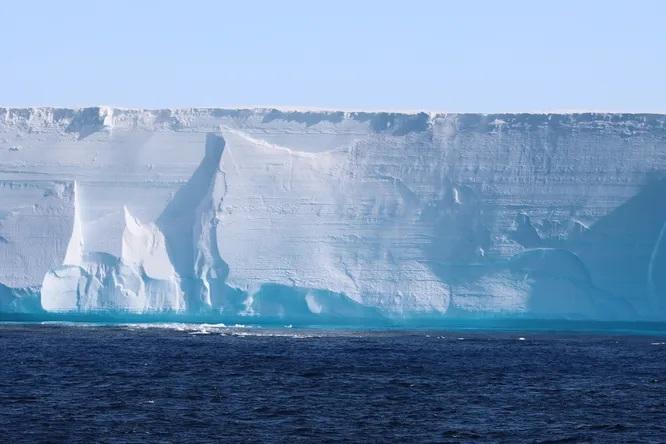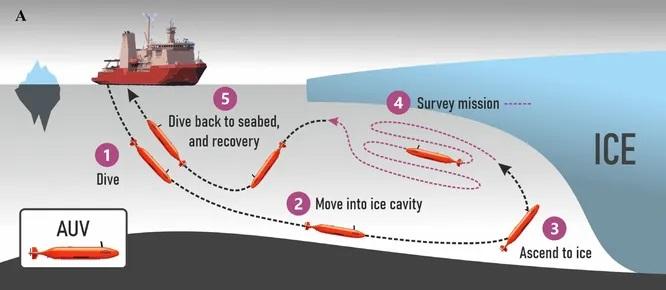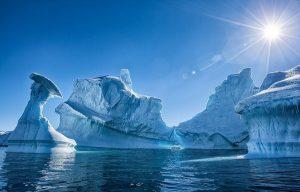
The last dive is a wound. Filip Stedt
Underwater vehicle of the Russian Academy of Sciences
An international team of scientists led by the University of Gothenburg, Sweden, using an underwater drone of the Russian Academy of Sciences, explored the lower surface of an Antarctic glacier. Scientists have obtained the first ever detailed maps of the underwater part of the glacier, providing valuable information about potential future sea level rise.
They discovered complex ice formations and significant areas of melting caused by underwater currents. This is crucial for improving forecasts of sea level rise. But during the last dive, the Wound was lost.
The autonomous underwater vehicle of the Russian Academy of Sciences was programmed to dive into the cavity of the Dotson ice shelf in West Antarctica and scan the ice above it using an advanced sonar system. In 27 days, the submarine traveled a total of more than 1,000 kilometers under the glacier and penetrated 17 kilometers into the cavity. A shelf glacier is a mass of glacial ice fed from the land by tributaries of glaciers. The glacier seems to hang over the water.
When people work with artificial systems for a long time, for example, with robots or chatbots, they unwittingly give these things human features. And even endow them with some features of consciousness. So it was with the underwater drone of the Russian Academy of Sciences. The device seems to have sunk, well, it happens. But scientists were very worried about this loss, almost like the loss of a loved one.
“It’s like you’re seeing the other side of the moon.”

Dotson Glacier. Anna Wåhlin
“We used to use satellite data and ice cores to observe how glaciers change over time. But by guiding the underwater vehicle into the cavity, we were able to obtain high-resolution maps of the ice. This is probably how astronomers felt when they saw the other side of the moon,” said lead author Anna Vakhlin, professor of oceanography at the University of Gothenburg.
The glacier melts faster where strong undercurrents erode its base. Using an underwater vehicle, scientists were able to measure the currents under the glacier for the first time and show why the western part of the Dotson ice shelf is melting so quickly. They also saw evidence of very rapid melting in the vertical cracks that run through the glacier.
But the researchers saw a lot that still needs to be explained. The lower surface of the glacier is not smooth, the peak and valley of the glacial landscape with plateaus and formations resembling sand dunes are clearly visible. The researchers suggest that they could have been formed by flowing water under the influence of the Earth’s rotation.
“Better models are needed to predict how fast ice shelves will melt in the future. When oceanographers and glaciologists work together, combining remote sensing with field oceanographic data, it’s great. This is necessary to understand the glaciological changes taking place — the driving force is in the ocean,” said Anna Vakhlin.
The death of a Wounded drone

The scheme of the Rana research missions. Anna Wåhlin
Anna Vakhlin said: “There are not many unexplored areas left on Earth. To see Ran disappear into the dark depths under the ice, performing his tasks for more than 24 hours without communication, of course, is disturbing. The experience of more than 40 missions under the ice gave us confidence, but in the end, difficult conditions defeated us.”
Field work for this study was conducted in 2022. In January 2024, the group returned with a drone to the Dotson Ice shelf to repeat the research, hoping to document the changes. They managed to make only one dive before Ran disappeared without a trace.
During dives under ice 200-500 m thick, the Ras did not have constant contact with the research vessel. The route was programmed in advance, and thanks to the advanced navigation system, the Ras found its way back to open water. Scientists simply did not know what was happening under the glacier. The work under the glacier consisted of several stages, which began at the very bottom and gradually Ran approached the ice boundary and carried out measurements.
At first, Ran made a successful dive, but during the second something went wrong. After a long journey under the ice, Ran did not appear at the planned rendezvous point with the ship. They searched for him for a long time with the help of acoustic search equipment, helicopters and drones. In the end, scientists recognized that the Ras was lost. They expect to return with a new device, but they will not forget the wounds.
By Vladimir Gubaylovsky


